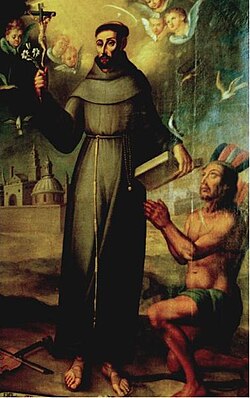Francis Solanus
| Saint Francisco Solano, O.F.M. | |
|---|---|

St. Francisco Solano with a native of Tucuman (Anonymous, ca. 1588) (Notice his trademark violin on the ground by his right foot)
|
|
| Wonder Worker of the New World | |
| Born | 10 March 1549 Montilla, Córdoba, Spain |
| Died | 14 July 1610 Lima, Viceroyalty of Peru, Spanish Empire |
| Venerated in | Roman Catholic Church |
| Beatified | 20 June 1675 by Pope Clement X |
| Canonized | 27 December 1726 by Pope Benedict XIII |
| Major shrine | Monastery of San Francisco, Lima, Peru |
| Feast | 14 July |
| Patronage | Argentina; Bolivia; Chile; Paraguay; Peru; also against earthquakes |
Francisco Solano y Jiménez, O.F.M., (also known as Francis Solanus) (10 March 1549 – 14 July 1610) was a Spanish friar and missionary in South America, belonging to the Order of Friars Minor (the Franciscans), and is honored as a saint in the Roman Catholic Church.
He was born 10 March 1549 in Montilla, the third child of Mateo Sánchez Solano and Ana Jiménez. He was educated by the Jesuits, but felt drawn to the poverty and penitential life of the Franciscan friars. At the age of twenty, he joined the Order of Friars Minor at Montilla, entering the novitiate at St. Lawrence Friary, which was located in a place of great natural beauty. The community there belonged to the Reformed observance within the Order, following a very strict routine of prayer, silence and fasting. Francis followed this regimen rigorously, always going barefoot, abstaining from meat, and wearing a hairshirt throughout that entire year. As a result, however, his health was permanently affected, leaving him sick and fatigued.
Solano was solemnly professed at the end of his novitiate year, on 25 April 1570. He was then sent to the friary of Our Lady of Loreto in Seville for his seminary studies. There he learned not only philosophy and theology but developed his musical talents. He was ordained in 1576, a ceremony his mother was unable to attend due to her poor health. He was then named Master of Ceremonies for the community. Still a lover of simplicity, Francis made a small cell for himself by the chapel of the friary, made of clay and reeds.
...
Wikipedia
